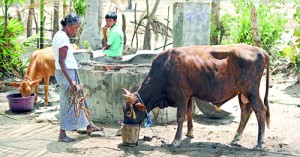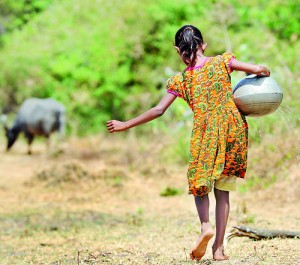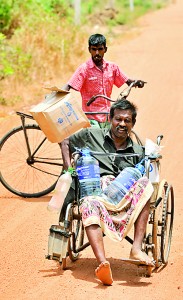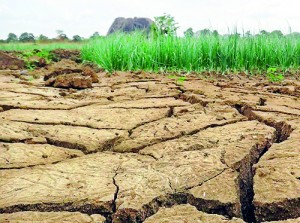News
Water reserves now critical at just 15 p.c. in north and east
Extreme hardship is setting in for the country’s north and east with the area’s total water resources now only 15 per cent full, and

Medirigiriya: In spite of being hit by the scarcity of drinking water this woman doesn’t fail to draw water for the cattle. Pic by Amila Gamage
water reserves at Ampara now at a critical level of 9 per cent and the major tanks in Trincomalee district nine-tenths empty.
The 11 major tanks in Anuradhapura are four-fifths empty.
Jaffna’s precious crops are failing in several areas.
Yala National Park has been closed as water for animals and drinking water for people in Kataragama is released from the Veheragala reservoir where the water level is just 2 per cent.
Even further south, Hambantota and Moneragala are experiencing difficulties.
Minor tanks have almost completely dried up while the water levels of major tanks are receding fast, said Irrigation Department Director (Water Management) Janaki Meegastenna.
“In Ampara, where there are eight major reservoirs, the active storage has reached 9 per cent and is declared a critical level. It is the same in Hambantota that has 11 major tanks and the water levels are just 7 per cent,” she said.

Polonnaruwa: A young girl walks far in search of water
In order for tanks to be filled the area should have 100mm or more rainfall for several days but there have only been scattered drizzles and animals and inland fish are suffering, Ms Meegastenna said.
Polonnaruwa Disaster Management Assistant Director, Upul Nanayakkara told the Sunday Times that even small springs have been drying up.
While there are complaints from frantic villagers that bowsers are not visiting them frequently enough, Mr. Nanayakkara said the bowsers have sometimes to travel 30-40km from the water plants.
The problem, he said, was that the people needed water containers that could hold 50- 100 litres but, being poor, they only possessed pots and buckets to store the

Wadigawewa: His disability doesn’t stop him from wheeling himself to collect much needed bottles of water that were distributed
precious liquid.
These few small household utensils are inadequate storage for the long periods between the visits of the bowsers criss-crossing the north central, north west and north east districts.
The Sunday Times learns that most divisional secretariats have only agricultural tractor bowsers that can hold about 1000 litres of water and are in dire need of bowsers that could hold more.
According to the Disaster Management Centre, more than 450,000 families (1.6 million people) from Moneragala, Polonnaruwa, Anuradhapura, Ampara, Batticoloa, Trincomalee, Kurunegala, Puttalam, Vavuniya, Hambantota, Mullaitivu, Mannar, Killinochchi and Jaffna are facing hardship due to the prolonged dry weather.

Dambulla: Parched paddylands. Pic by Kanchana Kumara Ariyadasa
In Polonnaruwa, officials are finding it hard to reach affected persons on a daily basis due to long distances from Water Board plants to areas such as Dimbulagala, Welikanda, Lankapura, Hingurakgoda, Medirigiriya and Elahera.
Jaffna GA Suntharam Arumainayagam said more than 10,000 families were affected by the drinking water crisis while another 25,000 persons were affected from failed agriculture.
He said initially Delft, Kayts, Karainagar, Velanai and Maradankulam were in difficulties but now hardship had spread to Nallur and Karavaddi as well.
Mannar Disaster Management Assistant Director Mohammed Riyaz said Mannar town, Nalattikulam, Musali, Maanthai West and Madhu were drought-hit.
This year’s expected 80,000 acres of paddy crop was never reached.
“Four additional water bowsers have been requested. At present there are eight, but most are tractor bowsers that cannot carry more water,” he said.
Moneragala Government Agent, A. Pathiananthan said 10 additional bowsers had been given by the army last week as the drought condition worsened. Food-for-work and cash-for-work programmes were taking place with the state involved with organsations such as the World Food Programme.
“As the drought condition worsens, the World Food Programme, with the Ministry of Economic Development, will commence the vulnerable group feeding programme in which the elderly and expectant women and women-headed households get food without working in return,” Mr. Pathiananthan said.
In the south, Hambantota district has 106,000 people suffering from the drought.
Hambantota Disaster Management Team Assistant Director K.K.M. Ravindra said although drinking water was being supplied daily and more bowsers were being hired, the agriculture sector was badly hit and the DMC and the Irrigation Department were putting in agro wells.
He said cash-for-work programmes were underway with Rs. 3000 being paid for six days of work and Rs. 6000 for 12 days.
The Hambantota Disaster Management Team consists of 14 Air Force officers and six civil officers.

